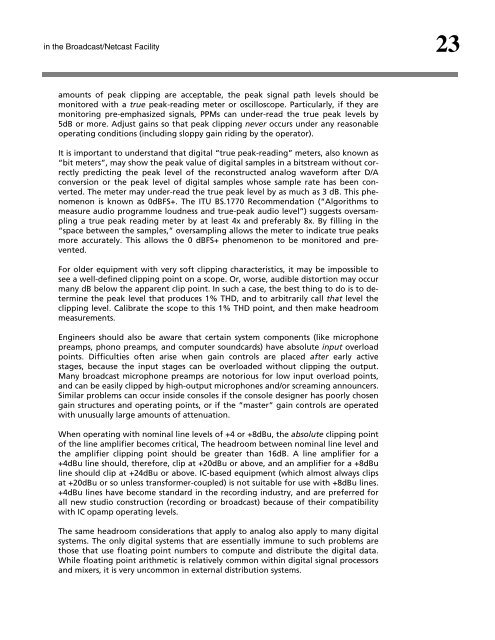Maintaining Audio Quality in the Broadcast Facility 2011 - Orban
Maintaining Audio Quality in the Broadcast Facility 2011 - Orban
Maintaining Audio Quality in the Broadcast Facility 2011 - Orban
You also want an ePaper? Increase the reach of your titles
YUMPU automatically turns print PDFs into web optimized ePapers that Google loves.
<strong>in</strong> <strong>the</strong> <strong>Broadcast</strong>/Netcast <strong>Facility</strong> 23<br />
amounts of peak clipp<strong>in</strong>g are acceptable, <strong>the</strong> peak signal path levels should be<br />
monitored with a true peak-read<strong>in</strong>g meter or oscilloscope. Particularly, if <strong>the</strong>y are<br />
monitor<strong>in</strong>g pre-emphasized signals, PPMs can under-read <strong>the</strong> true peak levels by<br />
5dB or more. Adjust ga<strong>in</strong>s so that peak clipp<strong>in</strong>g never occurs under any reasonable<br />
operat<strong>in</strong>g conditions (<strong>in</strong>clud<strong>in</strong>g sloppy ga<strong>in</strong> rid<strong>in</strong>g by <strong>the</strong> operator).<br />
It is important to understand that digital “true peak-read<strong>in</strong>g” meters, also known as<br />
“bit meters”, may show <strong>the</strong> peak value of digital samples <strong>in</strong> a bitstream without correctly<br />
predict<strong>in</strong>g <strong>the</strong> peak level of <strong>the</strong> reconstructed analog waveform after D/A<br />
conversion or <strong>the</strong> peak level of digital samples whose sample rate has been converted.<br />
The meter may under-read <strong>the</strong> true peak level by as much as 3 dB. This phenomenon<br />
is known as 0dBFS+. The ITU BS.1770 Recommendation (“Algorithms to<br />
measure audio programme loudness and true-peak audio level”) suggests oversampl<strong>in</strong>g<br />
a true peak read<strong>in</strong>g meter by at least 4x and preferably 8x. By fill<strong>in</strong>g <strong>in</strong> <strong>the</strong><br />
“space between <strong>the</strong> samples,” oversampl<strong>in</strong>g allows <strong>the</strong> meter to <strong>in</strong>dicate true peaks<br />
more accurately. This allows <strong>the</strong> 0 dBFS+ phenomenon to be monitored and prevented.<br />
For older equipment with very soft clipp<strong>in</strong>g characteristics, it may be impossible to<br />
see a well-def<strong>in</strong>ed clipp<strong>in</strong>g po<strong>in</strong>t on a scope. Or, worse, audible distortion may occur<br />
many dB below <strong>the</strong> apparent clip po<strong>in</strong>t. In such a case, <strong>the</strong> best th<strong>in</strong>g to do is to determ<strong>in</strong>e<br />
<strong>the</strong> peak level that produces 1% THD, and to arbitrarily call that level <strong>the</strong><br />
clipp<strong>in</strong>g level. Calibrate <strong>the</strong> scope to this 1% THD po<strong>in</strong>t, and <strong>the</strong>n make headroom<br />
measurements.<br />
Eng<strong>in</strong>eers should also be aware that certa<strong>in</strong> system components (like microphone<br />
preamps, phono preamps, and computer soundcards) have absolute <strong>in</strong>put overload<br />
po<strong>in</strong>ts. Difficulties often arise when ga<strong>in</strong> controls are placed after early active<br />
stages, because <strong>the</strong> <strong>in</strong>put stages can be overloaded without clipp<strong>in</strong>g <strong>the</strong> output.<br />
Many broadcast microphone preamps are notorious for low <strong>in</strong>put overload po<strong>in</strong>ts,<br />
and can be easily clipped by high-output microphones and/or scream<strong>in</strong>g announcers.<br />
Similar problems can occur <strong>in</strong>side consoles if <strong>the</strong> console designer has poorly chosen<br />
ga<strong>in</strong> structures and operat<strong>in</strong>g po<strong>in</strong>ts, or if <strong>the</strong> “master” ga<strong>in</strong> controls are operated<br />
with unusually large amounts of attenuation.<br />
When operat<strong>in</strong>g with nom<strong>in</strong>al l<strong>in</strong>e levels of +4 or +8dBu, <strong>the</strong> absolute clipp<strong>in</strong>g po<strong>in</strong>t<br />
of <strong>the</strong> l<strong>in</strong>e amplifier becomes critical, The headroom between nom<strong>in</strong>al l<strong>in</strong>e level and<br />
<strong>the</strong> amplifier clipp<strong>in</strong>g po<strong>in</strong>t should be greater than 16dB. A l<strong>in</strong>e amplifier for a<br />
+4dBu l<strong>in</strong>e should, <strong>the</strong>refore, clip at +20dBu or above, and an amplifier for a +8dBu<br />
l<strong>in</strong>e should clip at +24dBu or above. IC-based equipment (which almost always clips<br />
at +20dBu or so unless transformer-coupled) is not suitable for use with +8dBu l<strong>in</strong>es.<br />
+4dBu l<strong>in</strong>es have become standard <strong>in</strong> <strong>the</strong> record<strong>in</strong>g <strong>in</strong>dustry, and are preferred for<br />
all new studio construction (record<strong>in</strong>g or broadcast) because of <strong>the</strong>ir compatibility<br />
with IC opamp operat<strong>in</strong>g levels.<br />
The same headroom considerations that apply to analog also apply to many digital<br />
systems. The only digital systems that are essentially immune to such problems are<br />
those that use float<strong>in</strong>g po<strong>in</strong>t numbers to compute and distribute <strong>the</strong> digital data.<br />
While float<strong>in</strong>g po<strong>in</strong>t arithmetic is relatively common with<strong>in</strong> digital signal processors<br />
and mixers, it is very uncommon <strong>in</strong> external distribution systems.



![[PDF] Using the ITU BS.1770-2 and CBS Loudness Meters ... - Orban](https://img.yumpu.com/50629372/1/190x245/pdf-using-the-itu-bs1770-2-and-cbs-loudness-meters-orban.jpg?quality=85)






![[PDF] Optimod-FM Feature Comparison - Orban](https://img.yumpu.com/41741615/1/190x245/pdf-optimod-fm-feature-comparison-orban.jpg?quality=85)






